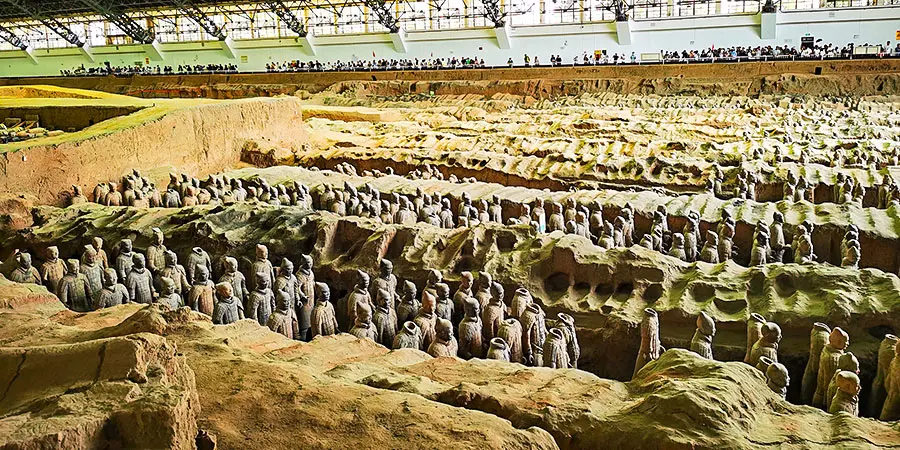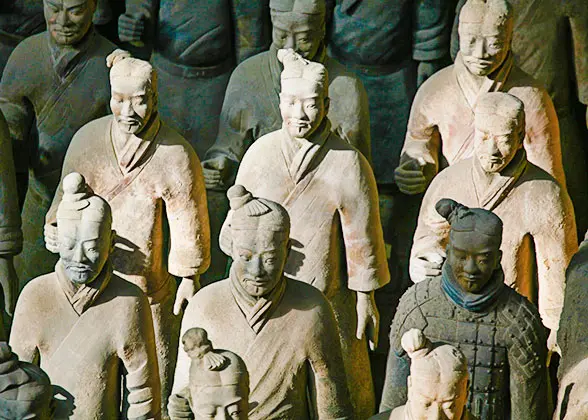Through the ages, scholars tend to pay special attention to the historical and aesthetic value of the Terracotta Army, and neglect its technological value. However, Lothar Ledderose, a scholar from Germany, discovered it and detailed the module and large-scale production of Terracotta Warriors in his book - Ten Thousand Things: Module and Mass Production in Chinese Art. Surprisingly, in Ledderose’s view, the module and mass production of Chinese artworks, represented by the Terracotta Army, contributes certainly to the rise of modern Europe.
Module and Mass Production of Terracotta Warriors
More than 2,200 years ago, how did Chinese ancestors make Terracotta Warriors on a large scale? According to the study of archaeologists, the module and mass production of Terracotta Warriors involves 4 aspects, which seems like a simple “assembly line”:
1. Module production of different parts
A terracotta warrior is composed of seven parts, including foot pedal, feet, legs, body, arms, hands and head. Although there are large quantities of clay warriors to be made, some parts are similar. Therefore, Chinese ancestors made the different parts separately and each part by a group of people. In fact, the parts of the crossbows used to be in the hands of Terracotta Warriors are also standardized, which proves the specialized division of labor
Qin Dynasty (221 - 207 BC).
 |
| Grand Terracotta Army |
2. Assemble different parts together
After all parts were done, they were assembled to shape terracotta warriors by a group of craftsmen.
3. Carve the details
After assembling the earthen warriors, it also involves body details and portrait processing, which combines industrialization and artistry. The masterly Chinese ancestors not only made the Terracotta Warriors with totally different facial expressions, but also made every soldier full of vitality. The life-size terracotta figures are just like vivid soldiers standing in front of us.
4. Mass production involved a big workmen team
The Terracotta Army was made by a team of massive workers, which was quite difficult to arrange in ancient times. In modern times, large factories with thousands of workers didn’t emerged until after the modern Industrial Revolution.
Porcelain Manufacturing Inherited the Module and Mass Production Process of Terracotta Warriors
After the establishment of the
Han Dynasty (202 BC - 220 AD), the handicraft industry management basically followed the Qin system. Although some of the processes were lost, most of them were still inherited. It is no exaggeration to say that almost all handicraft workshops of later dynasties were influenced by the Qin and Han Dynasties, including the large-scale porcelain production in Jingdezhen.
The Modular and Mass Manufacturing Process of Porcelain Spread to Europe
During the reign of Qing Emperor Kangxi (1662 - 1723), a French missionary named Pere Entrecolles came to China and was granted the permission to live in Jingdezhen for 7 years. Later, he was allowed to go in and out of the porcelain workshops at will. It was during this period that Pere Entrecolles easily acquired the Chinese porcelain manufacturing technology. Afterwards, he wrote a letter to Europe about the detailed way of modular and mass manufacturing process of porcelain in words and pictures.
The Modular and Mass Production Boosted the Rise of Modern Europe
The production mode of
Jingdezhen porcelain played a certain role in promoting the development of modern mass production technology after the Industrial Revolution in Europe in 17th - 18th century. In 1796, the British Josiah Wedgwood established Europe’s first porcelain production line with factory system and comprehensively division of labor, and equipped with workers specialized in one of the processes. The establishment of this innovative method at that time was just inspired by the letter written by Pere Entrecolles about Jingdezhen porcelain production.
- Last updated on Aug. 04, 2025 by Alex Jin -

